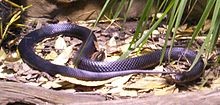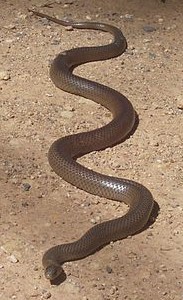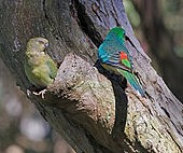
Contact

Home
H. J. McCooey part 4
Yowie / Bigfoot


DEMAND FOR WOMBAT.
Australian Town and Country Journal (NSW)
Date: April 11, 1885
Page Number: 28

THE SO-CALLED "WOOD ADDER."
Australian Town and Country Journal (NSW)
Date: April 18, 1885
Page Number: 25

The Northern Miner (Charters Towers, Qld.)
Date: May 23, 1885
Page Number: 2 S

"McCooey ... has taken as many as 36 young ones from the black snake"

Red-bellied Black Snakes are ovoviviparous; that is, they give birth to live young in individual membranous sacs. The young, numbering between eight and 40, emerge from their sacs very shortly after birth, and have an average length of about 122 mm. In the wild, few will survive to reproduce.

... I do not wish to underrate Mr. M'Cooey's zeal, but I strongly
advise him to be less rash in his assertions. I do not suppose any person in the country is soft enough to believe that he has travelled
over every square mile of New South Wales ; but if people know some of his assertions are not correct, they will not trouble to believe
what maybe quite correct...
HAVE WE ANY IGUANAS? THE LACE LIZARD (Hydrosaurus varius).
Australian Town and Country Journal (NSW)
Date: May 30, 1885
Page Number: 28

At Nevertire a collection of aboriginal implements was purchased by Mr. H. J. M'Cooey, Saturday,
on behalf of the trustees of the Australian Museum, and forwarded to Sydney. Mr. M'Cooey is well known in that district as a naturalist.
THE BROWN SNAKE (DIEMENIA SUPERCILIOSA).
Australian Town and Country Journal (NSW)
Date: June 27, 1885
Page Number: 28

THE LACE LIZARD (H. VARIUS).
Australian Town and Country Journal (NSW)
Date: June 27, 1885
Page Number: 28



THE BLACK SNAKE.
Australian Town and Country Journal (NSW)
Date: July 4, 1885
Page Number: 28


The Sydney Morning Herald (NSW)
Date: July 10, 1885
Page Number: 5


Red-rumped parrot

AUSTRALIAN SNAKES. — THE MAN OF SCIENCE AND THE "OLD BUSHMAN."
Australian Town and Country Journal (NSW)
Date: July 11, 1885
Page Number: 29
...
Many strange notions are entertained by "Old Bushmen" respecting our snakes, and their opinions, strange to say, are always found, as we shall presently see, to clash with those of scientific men.
...
It is true that he does not adduce proof in support of his assertion; but then it must be remembered that proof, as understood by men of science, is not at all necessary from the "old bushman's" point of view. Mere assertion and reiteration are sufficient for his purposes.
The "Old Bushman" is a somewhat mysterious or mythical personage, presumedly of great antiquity, and is supposed, when delivering his inspired utterances, to distort his visage in nine different directions at once, close the left eye, elevate the index finger of the right hand, and look in expressibly wise. His "experience," which always covers a period of 40 years, in many instances dates back to the days of Captain Cook, and far beyond the days of Captain Cook, till, to use the words of Lord Macaulay, "it is lost in the twilight of fable."
...
July 18, 1885 - SNAKE SWALLOWING.
I also noticed in the same issue another production of Mr. M'Cooey's on
the black snake, and to my thinking he is wrong. Bushmen in New South Wales, and not all old ones either, know from experience that
the black snake will swallow its young for protection, that is up to a certain size. I have seen a black snake startled on a warm
sunny morning, and the young ones all out, presumably warming in the sun, and she would glide along, making a hissing noise, with
her head six or seven inches above the ground, and have seen between 30 and 40 young snakes from six to seven inches long dive into
her mouth, and when the last one disappeared she could scarcely move, and was easily killed, together with the 35 young ones she had
just swallowed.
...
Of the accounts that have appeared in print—and there are many—the greatest weight has been given by herpetologists to those of Beauvois (1799, p. 371) and Ball (1915, p. 343), for both were trained observers. Yet Beauvois was, at the time of his experience, recovering from a serious illness that had greatly weakened him; and Ball, like so many others, recounted observations made years before as a boy at school.
The fact that this protective scheme is nearly always attributed to species of snakes that give birth to living young, instead of to egg-layers, is both a favourable and unfavourable criterion: favourable because it could be only these snake species whose young would be found in the company of their mothers, even for a brief time; unfavourable in that only in the case of these mothers could unborn young be inaccurately assumed to have been found in the mother’s throat or stomach, although really found in the uteri.
Reese (1942, p. 57; 1949, p. 174) believes that the existence of a habit of this kind should not be denied on purely negative evidence. The obvious reply is that if the habit is a myth, negative evidence will be the only kind available.
How stories of this kind may be duly confirmed in the retelling is suggested by the following chain: Ellen Gallwey (1934, p. 99) says that adders in England probably swallow their young for protection, as had previously been supposed, since a similar practice upon the part of rattlesnakes has been demonstrated by “Dr. Rudolph Menger, the American herpetologist.” But Miss Gallwey did not have access to Menger’s original paper; she had only second- or third-hand paraphrase. Actually, Menger (1905, p.15; 1913, p.154) merely recounts the observations of a friend; he makes no claim to having seen a rattler swallow its young. Incidentally, Menger asked a dealer who had handled 40,000 snakes within the previous 5 years whether he had ever seen such an occurrence, and received a negative reply.
This brings up another point, now of importance, that weighs against the protective-swallowing theory. Today there are annually born in the United States under accurate observation in laboratories and zoos, hundreds of broods of ovoviviparous snakes for every one under such observation 50 years ago. Yet, with all this multiplicity of broods, no mother has ever been seen to swallow her young for protection. Some of the mothers had been long in captivity, others but a few days when the young arrived. With all necessary allowances for the artificial effects of captivity, they would not completely nullify adherence to so ancient a custom if the story were true. In captivity, snakes may become tame and lethargic, yet they still retain many normal patterns of activity—the male combat dance, methods of courtship, and their ways of capturing and subduing food, for examples. Certainly some mother, of all the hundreds under observation, would by now have temporarily forgotten her cage and would have opened her mouth to protect her young. But none have done so.


HOW THE KANGAROO BREEDS.
Australian Town and Country Journal (NSW)
Date: August 1, 1885
Page Number: 28
...
I agree on my part to lay any sum of money from £25 to £200 that I can prove that the young of the kangaroo does not form or germinate on the teat, but that it is formed in utero and brought forth alive like non-marsupial mammals.
...

AUSTRALIAN BIRDS—THEIR WANTON AND RUTHLESS DESTRUCTION.
Australian Town and Country Journal (NSW)
Date: August 8, 1885
Page Number: 29

CARNIVOROUS MARSUPIAL.
Australian Town and Country Journal (NSW)
Date: August 22, 1885
Page Number: 28

Brush-tailed phascogale (Phascogale tapoatafa)

AN ALBINO GROUND PARROT.
Australian Town and Country Journal (NSW)
Date: August 22, 1885
Page Number: 28

HOW THE PLATYPUS BREEDS.
Australian Town and Country Journal (NSW)
Date: August 29, 1885
Page Number: 29
This question is now satisfactorily settled. The platypus lays eggs, and Mr. Caldwell, Natural History Fellow of Caius College, Cambridge, has been credited with the honor of the discovery. Mr. Caldwell, though not if responsible to any scientific body in this country was nevertheless good enough to appear before the members of the Linnean Society of Sydney, and verify his discovery. He exhibited the egg shells, made a statement, and answered all questions put to him.
...
It is no exaggeration to say that this is one of the most notable and important scientific discoveries of the nineteenth century. Students of the philosophy of Darwin are quite alive to the importance of this discovery
...

RE AUSTRALIAN SNAKES.
Australian Town and Country Journal (NSW)
Date: September 5, 1885
Page Number: 29


























